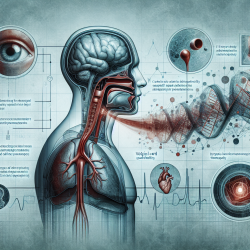Introduction
Vocal cord paralysis (VCP) is a condition that can significantly impact a person's ability to speak and swallow. While the common causes of VCP include trauma, surgery, and tumors, a lesser-known but equally important cause is spontaneous internal carotid artery dissection (ICAD). A recent case report and systematic review published in the Journal of Otolaryngology - Head & Neck Surgery sheds light on this rare but critical condition. As practitioners focused on creating great outcomes for children, understanding the nuances of this condition can help us make data-driven decisions to improve our therapeutic approaches.
Case Report Highlights
The case report discusses a 35-year-old male who presented with acute onset hoarseness and dysphagia. Initial examinations revealed left-sided VCP without an obvious cause. However, a subsequent MRI identified a left internal carotid artery dissection. The patient was treated with aspirin, and his symptoms resolved within 12 weeks. This case underscores the importance of considering ICAD in the differential diagnosis of idiopathic VCP.
Systematic Review Findings
The systematic review included nine cases of VCP due to ICAD. Key findings are:
- Seven patients had unilateral VCP, while two had bilateral VCP.
- MRI was used for diagnosis in seven cases, and five cases utilized angiography.
- All patients received antithrombotic treatment, with five experiencing vocal cord recovery in an average of 7.2 weeks.
These findings highlight the effectiveness of MRI in diagnosing ICAD and the potential for recovery with appropriate treatment.
Implications for Practitioners
As practitioners, we can draw several important lessons from this research:
- Early Diagnosis: MRI should be considered in the work-up of idiopathic VCP to rule out ICAD.
- Effective Treatment: Antithrombotic treatment, such as aspirin, can lead to significant recovery in vocal cord function.
- Long-term Follow-up: Continuous monitoring and follow-up are crucial for managing ICAD and preventing recurrence.
By incorporating these insights into our practice, we can enhance our diagnostic accuracy and treatment efficacy, ultimately leading to better outcomes for our pediatric patients.
Encouraging Further Research
While the current research provides valuable insights, there is still much to learn about the relationship between ICAD and VCP. We encourage practitioners to engage in further research to explore:
- The long-term outcomes of patients with VCP secondary to ICAD.
- The effectiveness of different antithrombotic treatments.
- The potential genetic and environmental factors contributing to ICAD.
By contributing to the body of knowledge on this topic, we can develop more effective strategies for diagnosis and treatment, ultimately improving patient care.
Conclusion
Understanding the link between vocal cord paralysis and internal carotid artery dissection can significantly impact our therapeutic approaches. By utilizing MRI for early diagnosis and implementing effective antithrombotic treatments, we can improve patient outcomes. We encourage practitioners to stay informed and engage in further research to continue enhancing our understanding and treatment of this condition.
To read the original research paper, please follow this link: Vocal cord paralysis secondary to spontaneous internal carotid dissection: case report and systematic review of the literature.










